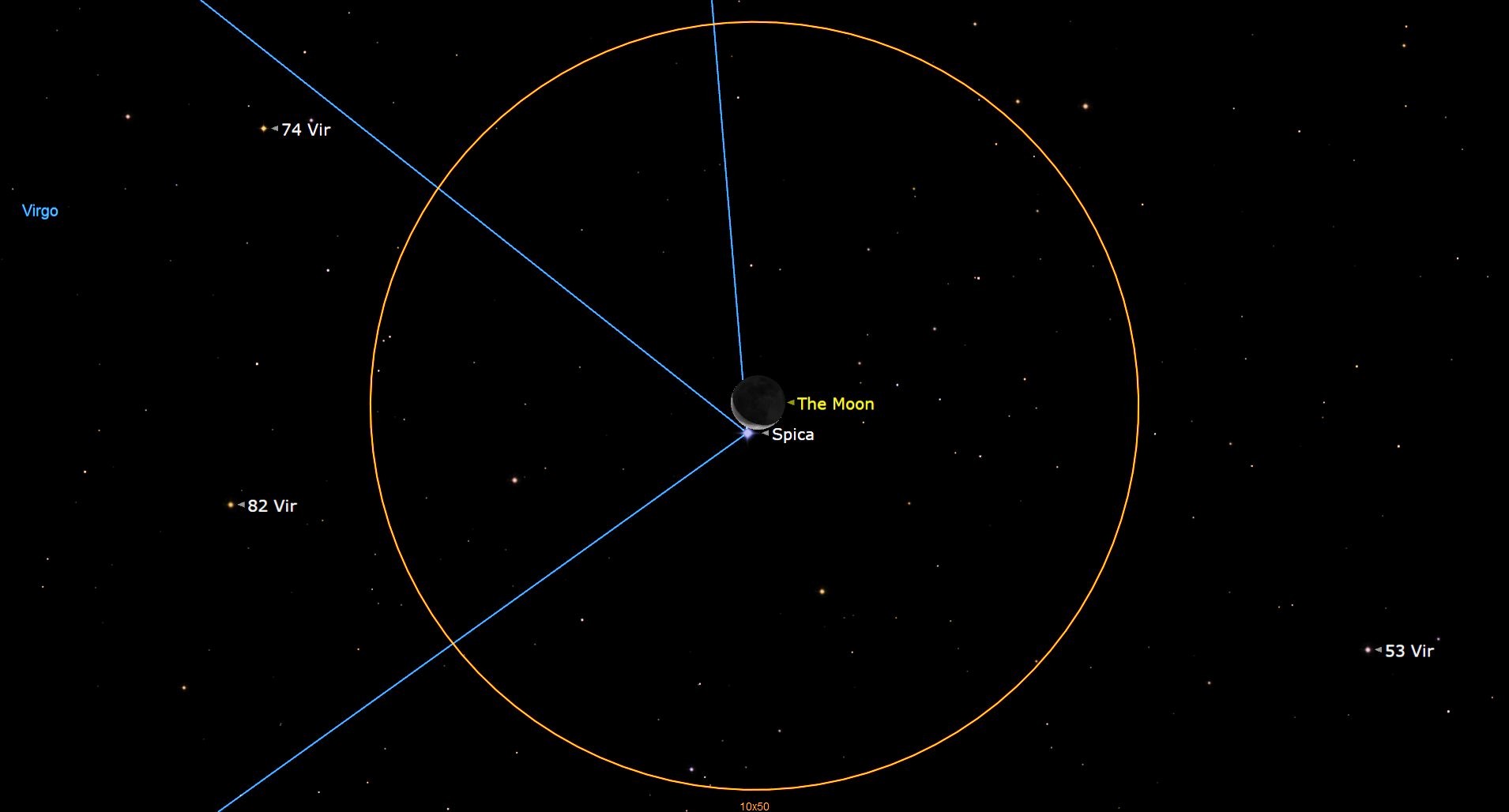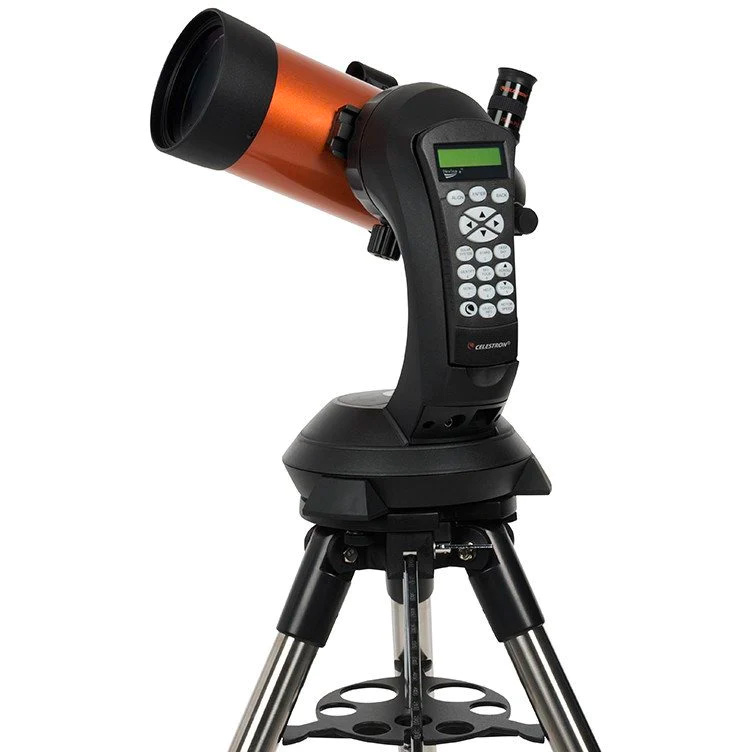
Earlier this month, the planet Saturn was eclipsed by the moon as seen from Central America, northwest portions of South America, as well as central and southern Florida. This event, known as an occultation (derived from the Latin word occultāre, which means "to conceal", can be a startling spectacle, especially if it involves a bright star.
But unlike a planet which can take up to a minute or two to be completely covered by the moon, a star, in contrast, appears to creep up to the moon's limb, hangs on the edge for a minute or two, and then, without warning, abruptly winks out. Later it pops back into view just as suddenly on the moon's other side. The suddenness with which occultations take place was one of the first proofs that the moon has no atmosphere. If our natural satellite were cloaked with an atmosphere, a star approaching its limb would appear to fade away gradually, just as if you were watching a bright star setting beyond the western horizon from here on Earth.
And on the morning before Thanksgiving Day in the U.S. (Nov. 27), just such a spectacle will take place for those living in the central and eastern parts of the United States and Canada when a slender waning crescent moon, just 13-percent illuminated, will occult the bluish 1st-magnitude star Spica, one of the 21 brightest stars in the sky.
Region of visibility

Want to see the moon or the stars of the night sky up close? The Celestron NexStar 4SE is ideal for beginners wanting quality, reliable and quick views of celestial objects. For a more in-depth look at our Celestron NexStar 4SE review.
The action begins when Spica disappears behind the moon's bright limb. This part of the event will probably require a small telescope, because glare from the moon's sunlit edge will tend to hide the star. In addition, over eastern Maine and Atlantic Canada morning twilight will already be in progress.
The star's reappearance will be spectacular wherever the moon is up in a dark sky. For any place west of a line running roughly from Sault Ste Marie, Ontario south to Mobile, Alabama, the sky will be completely dark when Spica springs into view from behind the moon's dark edge. Its sudden emergence should be able to be seen with the unaided eye if you have good vision, however the moon's glare might hinder the visibility of Spica. So, block as much of the moon's sunlit portion as you can with a finger, a telephone pole or the edge of a building at least 20-feet away. Binoculars will pull the star in well, and a small telescope will afford a superb view.
Those living east of that Sault Ste Marie-to-Mobile line will see Spica emerge during morning twilight; and the farther east you go, the brighter the background sky will get. For those who live near and along the coastal plain of the Middle Atlantic and Northeast U.S. Spica will unfortunately reappear at, or just after sunrise. Nonetheless, the moon should still be visible and provided that it is not too hazy, a good telescope should also bring out Spica as a tiny speck against the blue sky.
As one heads farther west, while the sky will be dark, both the moon and Spica will appear progressively lower in the east-southeast.
Get the Space.com Newsletter
Breaking space news, the latest updates on rocket launches, skywatching events and more!
And across a swath of the Northern Great Plains and most of the Rocky Mountain States, Spica will already be hidden when the moon rises, though its reappearance will be visible, albeit very low to the horizon. All prospective observers in these regions would be advised to scout out where they intend to watch the occultation a morning or two in advance, to make sure that there are no obstructions (like trees or buildings) between them and the rising moon. Compared to Nov. 27, the moon rises about 60 minutes earlier on Nov. 26; 122 minutes earlier on Nov. 25.
People residing in the Far West or Desert Southwest States will unfortunately find themselves outside of the occultation zone. The moon will rise above the east-southeast horizon at around 3:25 a.m. local time, having already passed Spica, with the star sitting to its upper left.

What to expect
In the table below, we provide a timetable for 15 selected locations, giving the local times for both Spica's disappearance and reappearance. "N/A" indicates that this particular event listed is not visible at this location because the moon and star are below the horizon.
A single asterisk (*) means the event occurs during morning twilight. A double asterisk (**) means the event occurs after local sunrise. As you can discern from examining the table, places in the central part of the U.S. and Canada will have the best views, with the occultation taking place from start-to-finish in a completely dark sky.
The information is based on predictions provided by the International Occultation Timers Association (IOTA) and has been rounded off to the nearest minute. For more detailed information, including a map of the occultation zone, as well as a timetable based on Universal Times (UT) for nearly 600 cities, click here.
| Location | Time zone | Spica disappears | Spica reappears |
|---|---|---|---|
| Denver, CO | MST | N/A | 4:21 a.m. |
| Helena, MT | MST | N/A | 4:26 a.m. |
| Kansas City, MO | CST | 4:28 a.m. | 5:29 a.m. |
| Chicago, IL | CST | 4:28 a.m. | 5:37 a.m. |
| Winnipeg, MB | CST | 4:29 a.m. | 5:34 a.m. |
| Amarillo, TX | CST | 4:36 a.m. | 5:14 a.m. |
| New Orleans, LA | CST | 4:45 a.m. | 5:19 a.m. |
| Washington, DC | EST | 5:34 a.m. | 6:48 a.m.* |
| Atlanta, GA | EST | 5:35 a.m. | 6:36 a.m.* |
| New York, NY | EST | 5:36 a.m. | 6:51 a.m.* |
| Montreal, QC | EST | 5:38 a.m. | 6:47 a.m.* |
| Boston, MA | EST | 5:39 a.m. | 6:52 a.m.** |
| Bangor, ME | EST | 5:44 a.m. | 6:51 a.m.** |
| Miami, FL | EST | 5:52 a.m. | 6:33 a.m.* |
| Halifax, NS | AST | 6:52 a.m.* | 7:53 a.m.** |
This is the second time this year that viewers in parts of North America have had a chance to see the moon occult Spica, the first time came last summer on July 12. Occultations of stars occur on a monthly basis in a series that can last for a year or two. This current series of Spica occultations began on June 16 over Eastern Europe and Northwest Asia and will continue until Nov. 17, 2025, concluding over Patagonia and part of Antarctica. Unfortunately, for North Americans this month offers the last chance to see the moon occult Spica in the current series.
The next series of Spica occultations will not get underway until February 2031, but it will not be until Leap Day (Sunday, Feb. 29) in 2032 that viewers in Eastern North America will be able to see a waning gibbous moon pass in front of Spica. And just four weeks later on March 28, all of North and Central America can watch as the moon again crosses paths with Spica during the early morning hours.
So don't miss out on this opportunity! Hope for clear skies on the morning before Turkey Day. If not, you'll have to wait more than seven years for your next chance at seeing the next interaction between Spica and the moon.
If you want to try your hand at capturing events like these on camera, we can help you find the info and gear you need. Check out our guides on how to photograph the moon or smartphone astrophotography to learn more about basic astrophotography skills. And if you need optical equipment or photography gear, consider our best cameras for astrophotography and best lenses for astrophotography.
Joe Rao serves as an instructor and guest lecturer at New York's Hayden Planetarium. He writes about astronomy for Natural History magazine, the Farmers' Almanac and other publications.
Editor's Note: If you get a great photo of any of the lunar occultation of Spica and would like to share it with Space.com's readers, send your photo(s), comments, and your name and location to spacephotos@space.com.
Join our Space Forums to keep talking space on the latest missions, night sky and more! And if you have a news tip, correction or comment, let us know at: community@space.com.

Joe Rao is Space.com's skywatching columnist, as well as a veteran meteorologist and eclipse chaser who also serves as an instructor and guest lecturer at New York's Hayden Planetarium. He writes about astronomy for Natural History magazine, Sky & Telescope and other publications. Joe is an 8-time Emmy-nominated meteorologist who served the Putnam Valley region of New York for over 21 years. You can find him on Twitter and YouTube tracking lunar and solar eclipses, meteor showers and more. To find out Joe's latest project, visit him on Twitter.
